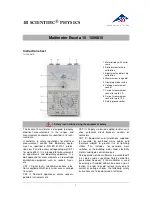
4
5.1 Current measurement
The nominal voltage of the voltage
source may not exceed 600 V. Do not
make measurements in the low-voltage
mains region.
The multimeter is to be connected in series with
the load on the side where the voltage with re-
spect to ground is lowest.
•
Before making any current measurements, set
the mode switch to
or
as appropri-
ate.
•
Connect the terminal at the lower potential
to the earth socket.
•
Currents of less than 3 A can be measured
between the earth socket and measuring
socket "A".
•
Currents of less than 3 A can be measured
between the earth socket and measuring
socket "A". Currents higher than 3 A should
be measured between the earth socket and
measuring socket "10A".
•
Set the switch to
A
mode and select the
desired measuring range. lf the current to be
measured is unknown beforehand, set the
measurement range dial to the highest
range and work down.
The fact that measurements can be made with-
out disconnecting the instrument and using
overload protection without fuses means that
converters may also be connected into the cir-
cuit.
V
A
10A
Fig. 1 Current measurement
5.2 Voltage measurement
The nominal voltage of the voltage
source may not exceed 600 V. Do not
make measurements in the low-voltage
mains region.
•
Before making any voltage measurements, set
the mode switch to
or
as appropri-
ate.
•
Use the "V" socket on the right for voltage
measurements.
•
Set the switch to
V
mode and select the
desired measuring range. lf the voltage to be
measured is unknown beforehand, set the
measurement range dial to the highest
range and work down. The 100 mV voltage
range is associated with a current range of
0.1 mA.
V
A
10A
Fig. 2 Voltage measurement
5.3 Measuring current and voltage without
reconnecting
Isolated current and voltage sockets allow
measurements of both current and voltage to be
made in sequence without disconnecting the
measuring leads. That means that in both AC
and DC modes, resistance, conductance, im-
pedance and admittance can all be calculated
forming the appropriate quotients.
V
A
10A
Fig. 3 Simultaneous current and voltage measure-
ment
5.4 Resistance and conductance
According to the defining equation for a linear
resistance,
R
=
V
/
I,
or conductance
G
=
I
/
V
, the
Escola 10 can be connected in circuit as in Fig.
3 so that current and voltage can be measured
one after the other, allowing for resistance
measurements to be made over a range from
m
Ω
up to several M
Ω
.
Therefore conductances in a range from under 1
µS up to 30 S can be measured by taking the
reciprocal of the resistance.
One very key advantage of the Escola 10 is that
the instrument, when connected as in Fig. 3, can
measure both current and voltage ranges with-
out having to disconnect it.






